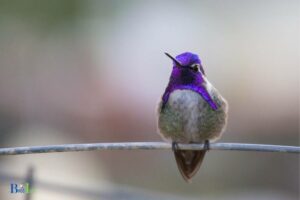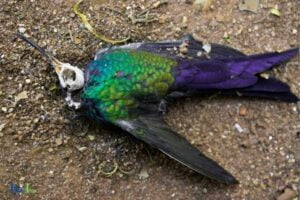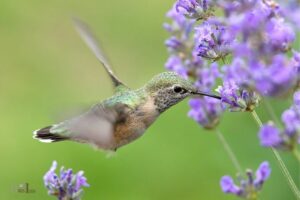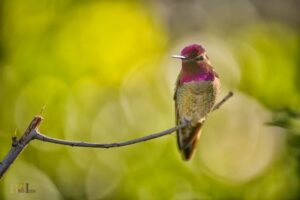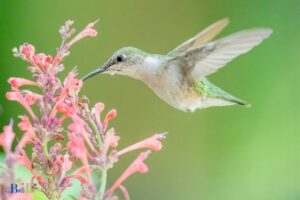How to Photograph a Hummingbird? 10 Steps!
To photograph a hummingbird successfully, use a fast shutter speed, a telephoto lens, appropriate lighting, and patience to capture stunning images of these quick and elusive birds.
Hummingbirds are small, fast-moving creatures that can be challenging to photograph, especially in flight.
To successfully capture their beauty and grace, it’s important to have the right equipment and settings, as well as understanding their behavior to anticipate their movements.
Key Takeaway
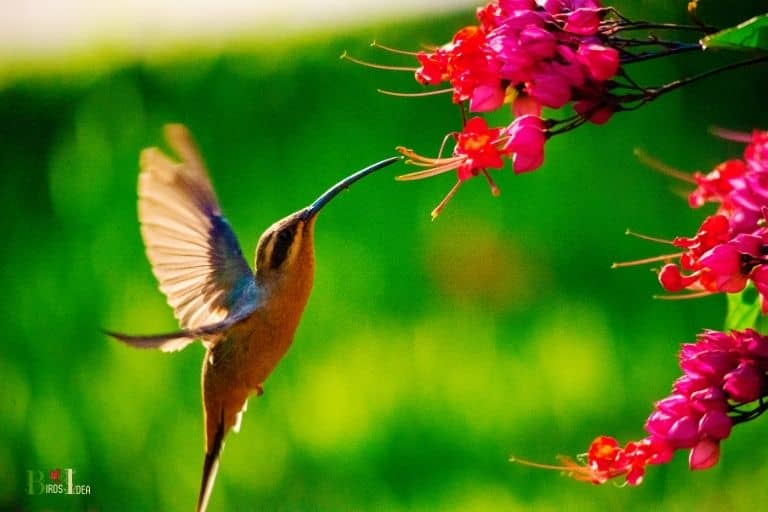
Here Are the Steps How to Photograph a Hummingbird
Photographing a hummingbird can be a challenging but rewarding endeavor. These tiny birds are incredibly fast and agile, making it a bit tricky to capture them in a photograph.
Here are some tips to help you capture stunning hummingbird photos:
Step 1: Choose the Right Equipment

Select a High-Quality Camera
To capture stunning hummingbird photos, start by choosing a high-quality camera with manual settings. A digital single-lens reflex (DSLR) or a mirrorless camera is ideal.
Pick the Right Lens
Use a telephoto lens with a long focal length (200mm or more) to get close-up shots of hummingbirds without disturbing them.
Step 2: Set Up Your Camera

Select Manual Mode
Switch your camera to manual mode, allowing you to control settings like aperture, shutter speed, and ISO.
Use a Fast Shutter Speed
Set your shutter speed to at least 1/1000th of a second to freeze the rapid wing movement of hummingbirds.
Adjust Aperture
Choose a wide aperture (low f-number) to create a shallow depth of field, blurring the background and making the hummingbird stand out.
Set a Low ISO
Keep your ISO as low as possible to minimize noise in your photos, usually around 100-400.
Step 3: Choose the Right Location

Find a Hummingbird Habitat
Visit gardens, parks, or areas with abundant flowers or feeders, as these are popular spots for hummingbirds.
Use a Perch or Feeder
Place a hummingbird feeder or a small branch nearby to provide a spot for the hummingbird to land and rest.
Step 4: Timing and Patience

Be Patient
Hummingbirds are fast and erratic, so prepare to wait patiently for the perfect shot.
Learn Their Patterns
Observe the hummingbirds’ flight patterns and feeding habits to anticipate their movements.
Step 5: Focus and Composition

Manual Focus
Use manual focus to ensure the bird is sharp. Autofocus may struggle with the rapid movements.
Compose Your Shot
Position the bird within the frame, considering the rule of thirds for a balanced composition.
Step 6: Lighting

Use Natural Light
Shoot during daylight hours for the best natural lighting. Overcast days can provide soft, even light.
Avoid Flash
Avoid using a flash as it can startle the hummingbirds.
Step 7: Continuous Shooting Mode

Burst Mode
Use your camera’s continuous shooting or burst mode to capture a series of shots in rapid succession.
Step 8: Post-Processing

Edit Your Photos
Transfer your photos to a computer and use photo editing software to enhance colors, sharpness, and remove any imperfections.
Step 9: Share Your Stunning Shots

Share Online
Share your beautiful hummingbird photos with friends and fellow photographers on social media or photography platforms.
Step 10: Respect Nature

Ethical Photography
Always prioritize the well-being of hummingbirds. Do not disturb or harm them while taking photos.
By following these steps, you’ll be well on your way to capturing captivating images of these incredible creatures. Happy hummingbird photography!
Understanding Hummingbird Behavior
Importance Of Knowing Their Behavior For Successful Photography
Hummingbirds are fascinating and beautiful creatures, and capturing their image in a photo can be a rewarding experience. To do so successfully, you need to understand their behavior and habits.
Here are some key points to keep in mind.
- Hummingbirds have a fast heart rate of up to 1,200 beats per minute. This rapid heartbeat is necessary for their high-energy lifestyle, which includes flapping their wings up to 80 times per second.
- These birds have an exceptional ability to hover, which is achieved by their unique wing structure that allows them to move in all directions.
- Hummingbirds are territorial animals and will fiercely defend their feeding sites from intruders.
- They have a high metabolic rate and therefore need to feed frequently, resulting in them hovering around feeding stations for extended periods.
Understanding these behaviors can help you get the best possible shot of a hummingbird.
Tips For Observing And Understanding Hummingbird Behavior
To capture a perfect hummingbird photo, you need to learn their behavior and habits.
Here are a few tips:
- Watch the hummingbirds from afar to get familiar with their movements and patterns. Observe the flight paths they take to and from their favorite feeding spots.
- Once you’ve found the hummingbirds’ feeding station, position yourself in such a way as to not disturb their natural habits. Hummingbirds have excellent vision which can detect human movement, so keep your movements slow and deliberate.
- Use a telephoto lens to capture their images as it will enable you to maintain a safe distance.
- Use a fast shutter speed to capture the bird’s quick movements and a high aperture to blur out the background.
- Keep in mind that these birds move a lot and are incredibly agile, so you’ll need to be patient, persistent, and observant to get the perfect shot.
By following these tips and paying close attention to their actions, you’ll be able to capture stunning hummingbird photographs. Happy snapping!
Setting Up Your Environment
Creating The Ideal Environment For Hummingbird Photography
When it comes to photographing hummingbirds, creating the perfect environment is key.
Here are some useful tips to help you set up your environment for ideal hummingbird photography:
- Choose a quiet location: Hummingbirds are easily spooked by noise, so it’s important to choose a quiet location. Avoid areas with loud noises or lots of foot traffic.
- Create a natural setting: Hummingbirds are more likely to visit natural-looking settings. Plant flowers and other plants that hummingbirds love such as trumpet vine, bee balm, and salvia.
- Set up bird feeders: Offering a hummingbird feeder is a great way to attract hummingbirds. Make sure to use a feeder that’s easy to clean and refill.
Choosing The Right Location And Time Of Day
Choosing the right location and time of day plays a significant role in hummingbird photography.
Here’s what to keep in mind:
- Early morning or late afternoon are the best times for hummingbird photography. During these times, the light tends to be soft and warm, making for great photos.
- Position yourself in a shaded area: Direct sunlight can create harsh shadows and overexposure in your photos. Position yourself in a shaded area for the best lighting.
- Find a spot with a clear view: Make sure the flowers and feeders aren’t obstructed by any objects. Having a clear view will allow you to capture clear shots of the hummingbirds.
Proper Positioning Of Flowers And Feeding Stations
Properly positioning your flowers and feeding stations is essential for capturing great hummingbird photos.
Here’s what to keep in mind:
- Place the flowers and feeders near each other: Hummingbirds often visit flowers and feeders interchangeably. By placing them near each other, you increase your chances of capturing photos of hummingbirds.
- Keep the flowers at varying heights: Hummingbirds are highly mobile and can fly in any direction. By placing flowers at different heights, you increase the likelihood of hummingbirds landing in your shot.
- Try different angles: Experiment with different angles to capture unique and interesting shots. Try crouching down or shooting from a higher elevation.
With these tips, you’re sure to create an ideal environment for hummingbird photography and capture some incredible shots.
Conclusion
Photographing hummingbirds can be a delightful and challenging experience for any photographer. These tips on how to photograph a hummingbird will help you capture them in all their beauty.
Remember to choose the right background, pay attention to lighting, use a tripod, set your camera on a shutter priority mode, and be patient.
These small birds can be unpredictable, so it’s crucial to have the right gear and a lot of patience to get the perfect shot. Remember, just like any photography project, practice makes perfect.
With the right tools, technique, and attitude, you will surely be able to capture breathtaking hummingbird photographs in no time.
Once you get the hang of it, you will realize that photographing hummingbirds can be one of the most rewarding experiences in your photography journey.

